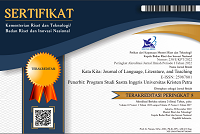CODE CHOICE USED BY THE EMPLOYEES IN THE COMMUNICATION WITH THE SUPERIOR AND THE CO-WORKER
DOI:
https://doi.org/10.9744/katakita.4.2.6-11Keywords:
Value Stream Mapping, Lead Time, Intra Transportation Process.Abstract
This study is about the choice of codes used by the employees in communicating with their superior and their co-worker. The thing that has caught the writer’s attention and curiosity to write on this particular topic is the language that is used by the employees in a work place like switching when they talk to the superior and the co-worker. The aims of this study were to describe and to analyze the codes which were used by the employees, to find out the dominant code they chose, and to explain what factors affected their choice of code. Through the analysis, the writer found that the employees chose to use standard or casual Indonesian codes in communicating with their superior. Whereas they used Javanese codes in communicating among themselves.
References
Holmes, J. (2001). An Introduction to Sociolinguistics. (5th edition). United Kingdom: Blackwell Publishing Ltd.
Saussure,F. (1974). Course in General Linguistics. London: Fontana.
Stockwell, P. (2002). Sociolinguistics: A Resource Book For Student. London: Routledge.
Wardhaugh, R. (2006). An Introduction to Sociolinguistics. United Kingdom: Basil Blackwell Ltd.
Downloads
Issue
Section
License
Authors who publish with this journal agree to the following terms:- Authors retain copyright and grant the journal right of first publication with the work simultaneously licensed under a Creative Commons Attribution License that allows others to share the work with an acknowledgement of the work's authorship and initial publication in this journal.
- Authors are able to enter into separate, additional contractual arrangements for the non-exclusive distribution of the journal's published version of the work (e.g., post it to an institutional repository or publish it in a book), with an acknowledgement of its initial publication in this journal.
- Authors are permitted and encouraged to post their work online (e.g., in institutional repositories or on their website) prior to and during the submission process, as it can lead to productive exchanges, as well as earlier and greater citation of published work (See The Effect of Open Access).














